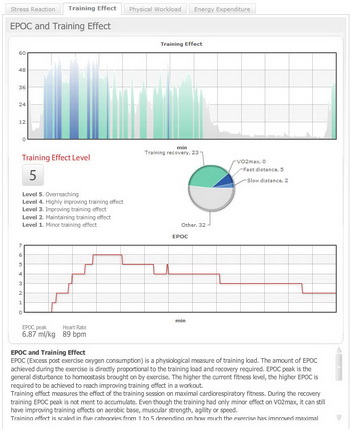Optimize Training and Recovery.
Workouts may not always have the intended effect.
EPOC (excess post-exercise oxygen consumption)
EPOC Based on Heart Rate
EPOC (excess post-exercise oxygen consumption) is the excess oxygen consumed during recovery following exercise as compared to resting oxygen consumption. EPOC can be used to accurately assess training load. Known as the EPOC prediction method, it is a physiology-based calculation based on heart rate (HR) measurement.
Assessing the affect of exercise
Every individual differs from the next. Your capacity for physical exertion is different from a professional athlete and even among pros there is variance in physiology. As a result, there is no universal exercise plan to improve fitness.
When pushed sufficiently, the body experiences a homeostatic disturbance which improves fitness levels. However, when not pushed enough the body will not change and when pushed too much the body can become strained. The latter is particularly relevant to athletes whose overtraining can seriously impact their career and livelihood. Measuring and understanding your training load solves this uncertainty.
Methods of measuring training load
Training load can be assessed using either subjective or physiological measures. Subjective measures are accessible but do not take into account physiological responses and recovery demand. As a result, subjective measures lack precision and scope.
Physiological measures analyze factors such as oxygen consumption, heart rate and blood. These variables are used to measure the momentary intensity of exercise but do not reflect the duration or cumulative effect of the activity.
EPOC is another physiological measure which analyzes the amount of oxygen consumed in excess after exercise. This value reflects the recovery demand and the disturbance of the bodys homeostasis caused by physical exertion. Traditionally, EPOC could only be measured using specialized laboratory equipment. While extremely accurate, the EPOC method of analyzing respiratory gases was impractical, time-consuming and expensive.
QAthlete recognized the need for a practical physiology-based training load measure. After years of scientific research and application, we developed an easy-to-use system for estimating EPOC using heart rate measurement.
This solution is efficient, accessible and effective.
Important EPOC facts:
Scientists first observed an elevated resting metabolic rate after exercise in 1910
EPOC is used to represent both oxygen re-payment during recovery and homeostatic disturbance after exercise
When graphed, EPOC is calculated by subtracting the area under resting VO2 from the area under the recovery VO2 curve
EPOC values get higher with increased intensity and/or duration of exercise
The EPOC prediction method
EPOC can be derived using the following mathematical formula:
EPOC (t) = f(EPOC(t-1), exercise_intensity(t), dt)
This formula was developed based on a series of peer-reviewed articles, practical studies and meta-analysis data. The model was constructed using 158 test subjects which included both fit and unfit males and females. Tests were conducted in 48 exercise settings and activity varied in both duration (two to 180 minutes) and intensity (18 to 108% V02max).
Heart rate data was collected from the subjects who ran, cycled and executed upper-body exercises. The model was able to successfully predict EPOC at any given moment using heart rate data without the need for post-exercise measurement.
Other important EPOC characteristics:
When exercising at a low intensity (<30-40%VO2max), EPOC does not accumulate significantly after the initial increase at startup
When exercising at a high intensity (>50%VO2max), EPOC accumulates continuously
EPOC as a Measure
EPOC is the physiological measure of training load. Essentially, it is the value given to excess oxygen consumed during post-exercise recovery as compared to resting oxygen consumption. The amount of EPOC achieved during exercise is proportionate to the training load and recovery required.
Finding the perfect balance between working out too lightly and pushing too hard is essential for improving physical fitness. EPOC is the ideal indicator for measuring training load and creating the perfect workout.
EPOC is your secret weapon
EPOC indicates the physical effects of an entire training session or a single workout snapshot
Applicable to any type of exercise at any intensity, with or without breaks
Learn about your bodys need for rest (e.g. higher EPOC indicates insufficient recovery from previous sessions)
Understand the science of fitness: harder and longer sessions produce a higher buildup of EPOC
In the past, EPOC could only be calculated following an exercise session in a controlled laboratory environment using breath analysis. The method was expensive, restrictive and time-consuming. We now have an accurate and reliable method of predicting EPOC based on heart rate during exercise. This method has demonstrated remarkable precision within 0.89 of traditional EPOC measurement.
The key benefits of EPOC as a measure of training load:
Backed by scientific studies, laboratory trials and peer-reviewed data
Scientifically recognized as effective and accurate
Objective, physiology-based measure
Noninvasive, convenient, comfortable, affordable and efficient
